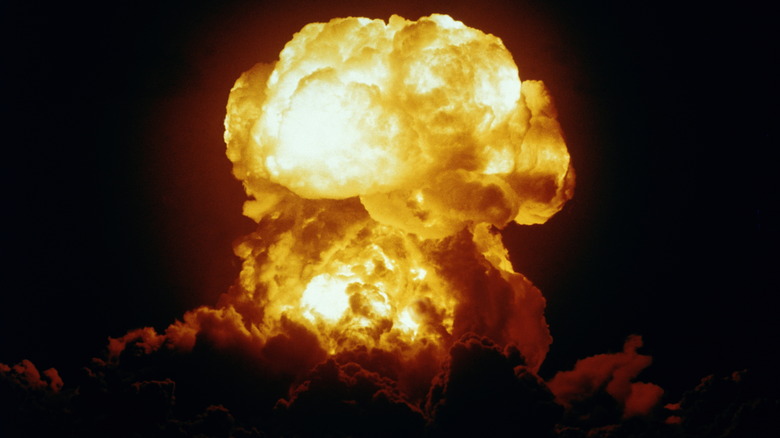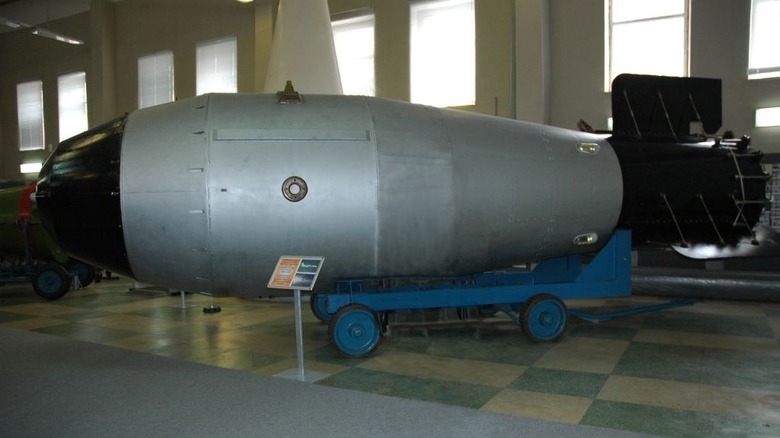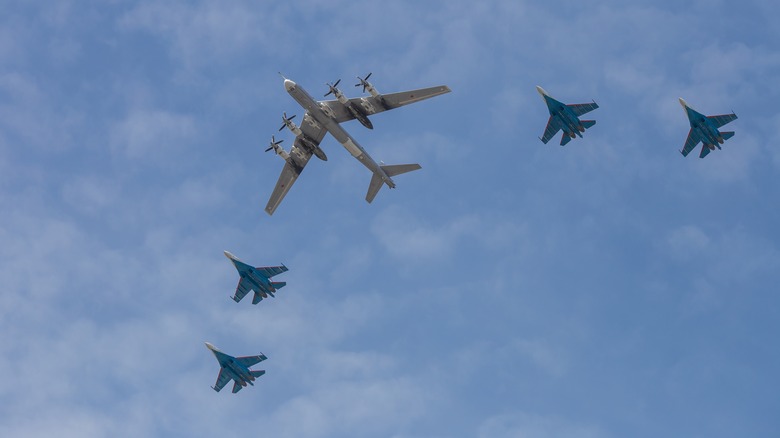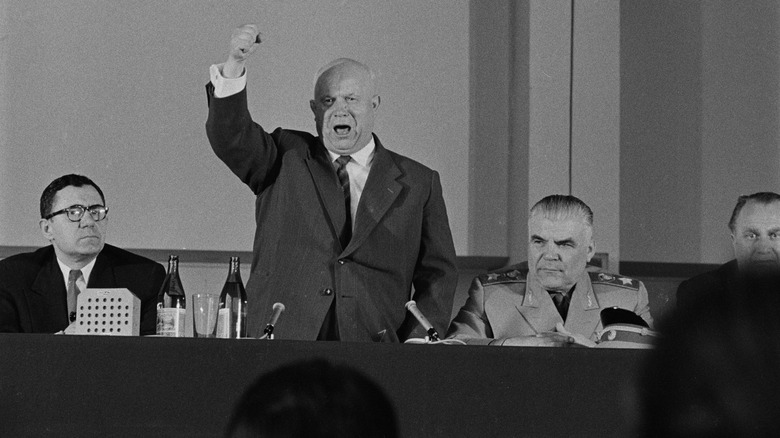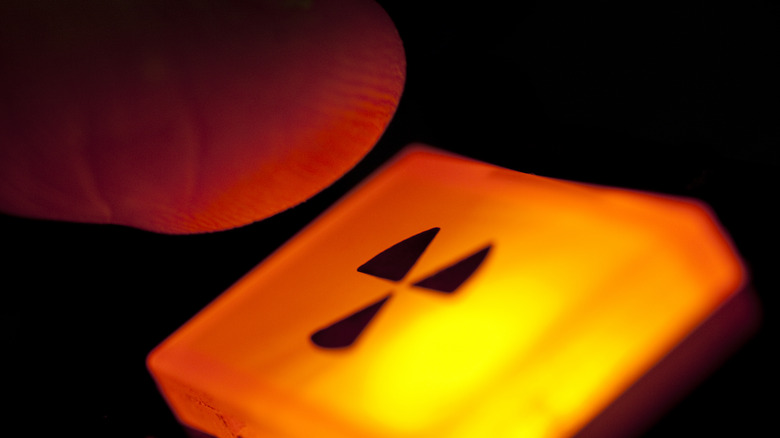Disturbing Facts About The Most Powerful Nuclear Bomb Ever Made
As if nuclear weaponry wasn't horrifying enough, some nuclear bombs are more horrifying than others. The bombs Little Boy and Fat Man that the U.S. dropped on Hiroshima and Nagasaki towards the end of World War II killed an estimated 320,000 total people, taking into account the initial blast, radiation sickness, cancer, and all other effects combined. While it's hard to imagine such devastation being caused by only two bombs, these two bombs were specks in comparison to the most devastating nuclear bomb ever made, the RDS-220, aka the Tsar Bomba, or "King of Bombs."
Developed by the Soviet Union in the middle of the Cold War, the Tsar Bomba was meant to make a political statement more than anything else. "Let the 100-megaton bomb hang over the capitalists like a sword of Damocles!," Soviet head of state Nikita Khrushchev said at the time (per The Bulletin). And yes, he meant 100 megatons, no matter that it was only detonated at 50. The bomb was 1,570 times more powerful than Little Boy and Fat Man combined and had an explosion power equal to 10% of all the explosives used in World War II altogether.
As recently as 2020, Russia declassified and released its Tsar Bomba test footage, which dates to 1961. The bomb was dropped on the deserted island of Novaya Zemlya in the Arctic Circle to the northwest of Russia and blew out glass in windows 560 miles away. It also sent a up mushroom cloud halfway into space. To this day it's the single most powerful weapon detonated on Earth, ever.
Tsar Bomba by the numbers
Without a doubt, it's the potency of Tsar Bomba that stands far above all other disturbing facts about the bomb. The atomic bombs dropped on the Japanese cities of Hiroshima and Nagasaki during World War II — Little Boy and Fat Man — had yields equaling 15 and 21 kilotons, respectively. As mentioned, those bombs plus their fallout caused the deaths of nearly 320,000 Japanese people. Tsar Bomba, by contrast, generated an explosion equaling 57,000 kilotons, a number rendered just as incomprehensible as the bomb's power.
An illustration of Tsar Bomba's mushroom cloud on Radio Free Europe paints a vivid story. The mushroom clouds from Little Boy and Fat Man passed the cruising height of most airplanes and even passed the summit of Mt. Everest. Tsar Bomba's mushroom cloud passed through three of Earth's five atmospheric layers and into its thermosphere 60 miles above the planet's surface. That's over halfway to the height that space shuttles orbit Earth.
The bomb's flash was visible 620 miles away. According to the Atomic Heritage Foundation, despite being detonated 13,000 feet above the ground the bomb caused seismic rumbling on par with a 5 to 5.25 earthquake, and its entire yield was equally 25% of the 1883 explosion of the Krakatoa volcano, which itself was heard almost 1,900 miles away. All in all, it's not an understatement to say that Tsar Bomba was a truly existence-ending weapon.
A hydrogen bomb detonated at half strength
Tsar Bomba wasn't an atomic bomb like Little Boy or Fat Man — it was a hydrogen bomb, a type of vastly more destructive weapon. Folks who watched Christopher Nolan's "Oppenheimer" might remember scientist Edward Teller, who wanted to push past the Trinity Test's focus on atomic bombs and go straight to hydrogen bombs. Thankfully, his preference was overruled. As the Bulletin explains, such "bigger bangs" also became the goal in Soviet bomb testing following an initial 1955 hydrogen bomb test. Big wasn't big enough. Soviet authorities wanted a bomb that was truly, absurdly cataclysmic.
As Radio Free Europe outlines, atomic bombs rely on nuclear fission, i.e., breaking atoms apart to create explosions. Hydrogen bombs break atoms during their first step and then re-fuse them into new elements via nuclear fusion during their second step. It's the fusion of these new elements that causes a hydrogen bomb's colossal thermonuclear explosion. Tsar Bomba, then, was the most destructive hydrogen bomb ever created.
Soviet physicists, however, grew worried about the fallout from testing such an immense weapon, no matter that Tsar Bomba was set to detonate over an uninhabited island. This is especially true of Andrei Sakharov — the U.S.S.R.'s equivalent of J. Robert Oppenheimer — who resisted pushing the bomb further, even under the thumb of the Soviet government. Ultimately, Soviet physicists swapped out Tsar Bomba's uranium casing for a lead one. Otherwise, the bomb's potency would have been twice as powerful, at 100 kilotons.
[Featured image by User: Croquant with modifications by User: Hex via Wikimedia Commons | Cropped and scaled | CC BY-SA 3.0 DEED]
Terrifying eyewitness accounts
With a bomb so destructive you might be wondering how anybody could have witnessed the blast and survived. Some people did, however, including the crew of the Tupolev TU-95 that dropped the bomb. The nine people on board the plane, plus five others on a smaller escort plane, were only given a 50% chance of survival. And yet, they watched Tsar Bomba's mushroom cloud climb to a height of nearly 60 miles, while the plane itself capped out at a height of about 8.5 miles. But, they barely survived. When Tsar Bomba went off the Tupolev fell to a height of 3,300 feet above the surface before the pilot could regain control.
Eyewitness accounts are particularly horrifying. Per the Nuclear Weapon Archive, one Soviet cameraman said: "The sea of light spread under the hatch and even clouds began to glow and became transparent. At that moment, our aircraft emerged from between two cloud layers, and down below in the gap a huge bright orange ball was emerging ... Slowly and silently it crept upwards." Another observer far away heard "a remote, indistinct and heavy blow as if the earth has been killed!"
Most terrifyingly, a photographer at ground zero after the fact said, "The ground surface of the island has been leveled, swept, and licked so that it looks like a skating rink. The same goes for rocks ... There is not a trace of unevenness in the ground ... Everything in this area has been swept clean, scoured, melted, and blown away."
The political bomb of Damocles
It could be argued that a nuclear weapon is only as dangerous as the person whose finger is on its trigger. Tsar Bomba — and any bomb like it — is terrifying enough. But when such a weapon sits couched in the arsenal of a vocally antagonistic nation who threatens to use it? As The Bulletin explains, this is exactly what happened back in 1961, when leader of the Soviet Union Nikita Khrushchev bellowed the line: "Let the 100-megaton bomb hang over the capitalists like a sword of Damocles!" For those unfamiliar with the tale, Damocles was a courtier under the ancient tyrant Dionysius II of Syracuse. In addition to wonderful food and drink, Dionysius hung a sword above Damocles' head suspended by a thread in case the man displeased him.
But despite Khrushchev's boast, it turns out that the Tsar Bomba project was mostly meant as a bit of chest-thumping for the global stage. At the time, other nations regarded the bomb as "an object of infamy, recklessness, and terror," per The Bulletin. But, it was too big to be deployed in any practical way — as big as a bus. It was also too heavy to be attached to a missile (27 tons), and even when it was dropped during testing it had to be attached to a parachute. Nonetheless, in the wake of Tsar Bomba's detonation, the U.S. started developing a bomb that was 20 times more powerful.
An unwieldy peace
Two years after Tsar Bomba's 1961 test, the United States, the United Kingdom, and the Soviet Union signed the Limited Test Ban Treaty in 1963, which banned all nuclear testing: in space, in the ocean, on land — you name it. It took five years of negotiations to bring this treaty to fruition and even encompassed the time period when the U.S.S.R. developed and dropped Tsar Bomba. Regardless, the treaty not only passed but paved the way for other, more comprehensive treaties like 1968's Nuclear Non-Proliferation Treaty. And so, Earth and its people got a second lease on existence — at least for a while. The Tsar Bomba faded from memory and became a relic of history.
However, it's easy to be cynical about such things. After all, what about countries that weren't involved in such peaceful proceedings? What's to stop a nation that signed such treaties from using a nuclear weapon if pushed, anyway? The de-escalation of nuclear tensions in the 1960s and '70s is a rare instance of humanity choosing to pull back from the brink rather than race towards it, especially where weapons technology is concerned. As recently as March 2024, for instance, Russian President Vladimir Putin once again threatened to deploy nuclear weapons to defend, "the existence of the Russian state, our sovereignty and independence," per Time Magazine. Considering that a nation need not build a single Tsar Bomba, but just many smaller bombs to the same effect, such words prove chilling, indeed.
